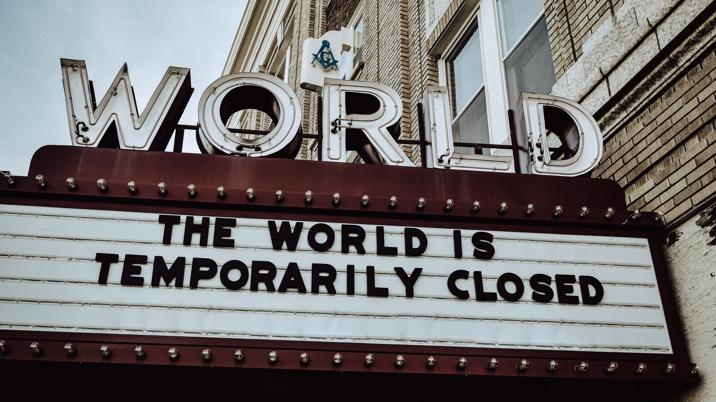
Like people around the world, Americans still alive at this writing are hoping that they do get the chance to display new-found strength some day. In our case, that means trying to avoid being killed by the pandemic despite the best efforts of the moronic Mussolini impersonator currently occupying the White House. Judging by his sinking polls, all but the true Trump zombies – the same ones who still believe that Covid-19 is a hoax, and had to be warned not to ingest Lysol or bleach despite the advice of their fearless leader – are still trying to defend his bizarre, life threatening behaviour. (Sorry André Leon Talley, but in my book, Anna Wintour earned absolution for all sins real or imagined when she publicly goaded Trump to be the first to try drinking disinfectants.)
In the face of all this, some might view it as parochial or even shallow to focus on the media’s woes right now. After all, nearly all businesses are being pummelled by this crisis. But the media’s fate is more crucial than ever, because legitimate outlets are keeping truth alive, as the dark forces do their best to squelch human rights and freedoms.
Trump and his accomplices are stepping up their blitzkrieg on the heroic national media.
News media
Sadly, after so many years of struggle and consolidation, the pandemic advertising crash is threatening the actual extinction of the local newspapers that are so critical to grassroots democracy, despite their pumped-up readerships due to the very same crisis. Democratic lawmakers lacked the votes to get needy newspapers (or magazines) included in eligibility for the trillions in “small” (ha!) business loans.
Meanwhile, Trump and his accomplices are stepping up their blitzkrieg on the heroic national media that have been revealing his corruption every day for nearly four gruelling years. Trump’s Big Lies have succeeded at turning some Americans – a minority, but a still discouragingly significant percentage – against the very media that have so far kept him from actually seizing the “total power” that he believes he already has. (Why does the movie Seven Days in May keep haunting my dreams? Guess.)
While the most visible and impactful media have been The Washington Post and The New York Times, digital-only outlets including ProPublica, BuzzFeed and The Daily Beast have also made substantive contributions, along with The Atlantic, Mother Jones, The Nation, Harper’s, New York and Vanity Fair, among other magazine brands.
We’ve never been in greater need of the inherent therapeutic powers of professionally written and produced content about the things that we love.
Magazine media
As for magazine media that don’t delve into politics, with all we’re coping with now, we’ve also never been in greater need of the inherent therapeutic powers of professionally written and produced content about the things that we love, and help keep us sane: food, home renovation / décor, DIY everything, special interests of every stripe, and good old celebrity gossip.
So, what are the odds for the magazine media industry now?
The good news: There were indications that, at least in early pandemic days, consumption of magazines in print, as well as digital channels, was uptrending – particularly among younger consumers. In mid-April, Hearst reported seeing a whopping 42% month-over-month jump in subscription sales, and Meredith also confirmed that subs were on the upswing. Even single-copy sales (mirabile dictu!) saw a significant increase during the early weeks of the outbreak, thanks to checkout queues as people stocked up in supermarkets – though publishers expect that to fizzle now that foot traffic is down. All of the big publishers have also been reporting big increases in their digital user metrics.
But as we know all too well, the horrible irony is that advertisers are slashing budgets at this time of heightened consumption due both to consumers’ absence from all but food stores and because of their (ludicrous, in my opinion) fear of having brands mentioned near the coronavirus content to which we’re all flocking.
Based on a March survey of media buyers and planners, Statistica projected that US print advertising spending would drop 43% in March-April and 34% in May-June, compared to planned spending for those periods prior to the pandemic. MediaVillage analyst Jack Myers is forecasting an ad revenue fall of more than 16% for the US magazine industry as a whole for this year, with some publishers falling as much as 50% below their pre-Covid-19 budget projections. ECI Media Management projects that magazine ad prices will decline 17% this year – more than newspapers (-11.8%), radio (-9%), TV (-5.9%) and OOH (-4.6%). Prices for digital video and digital display are expected to rise slightly (1.3% and 0.3%, respectively), which could theoretically bring some relief for magazine brands… if their digital properties could manage to wrest some share away from the big tech platforms.
The fallout thus far isn’t pretty. Many smaller magazine companies are hanging on by their fingernails, and having already cut their staffs and / or reduced or ceased publishing their print versions. (Rather than try to detail the carnage here, I’ll refer you to Poynter.org, which has been keeping a running list of media casualties.)
All of the big publishers have also been reporting big increases in their digital user metrics.
Meredith
The three biggest magazine publishers are still dependent on advertising to one degree or another, of course. As of last year, Meredith, the only publicly traded of the three, reported that its consumer-generated revenue (circulation, product sales, licensing) had risen from 27% of total revenue a decade ago to 45%. So advertising still rules – although Meredith gets a considerable chunk of its ad revenue from local TV, which, as noted, should be somewhat less impacted than print. Further, Meredith had already battened down its hatches through rounds of layoffs and restructuring after its Time Inc acquisition, and further curtailing of costs in last year’s second half, after a notably poor earnings report.
Nevertheless, Meredith has announced temporary pay cuts for about 60% of its 5,000 employees, with the largest percentages hitting higher-paid executives. In addition, the company is offering voluntary early retirement to 170 employees in its magazine and television broadcasting divisions.
Meredith hasn’t made any changes to print frequency, but told WWD it’s made contingency plans, prioritising which titles’ issues would be reduced if that became necessary.
Digital display advertising is also currently in big trouble – and live events are dead in the water.
Condé Nast
Condé Nast, which had already gone through a series of wrenching restructurings and cost saving moves in recent years, may be the hardest-hit of the three by the current advertising and events implosion. The company has pushed hard to diversify its business, at least in the past few years. And as of last year, it was claiming that print magazine advertising’s share of total revenue had declined in just five years from 80% to 60%. But as noted, digital display advertising is also currently in big trouble – and live events are dead in the water.
Condé has acknowledged internally that the revenue hit will force it to implement layoffs in the “low single digits” on its 6,000-person workforce (likely to amount to several hundred, according to various reports). It publicly announced temporary pay cuts for all employees making over $100,000 per year, some furloughs, and the postponement of most hiring and investments, including infrastructure and events operations.
In addition, Condé has shifted some of its publishing schedules, hoping for improved ad budgets in later months. Vogue is publishing a combined June/July issue, but will add a holiday issue, so the total issues won’t be reduced. Condé Nast Traveler (whose frequency was cut from ten to eight in 2017) will publish an August/September issue instead of a July/August issue. Vanity Fair will publish a combined July/August issue (instead of a combined June/July issue).
Hearst
Hearst, having had to begin responding to the internet-driven newspaper crisis starting decades ago, has diversified outside of media into less volatile sectors like financial, medical and other data and software. That diversification produced record results last year, which provided a strong base to work off of when the pandemic hit. But advertising in its magazine and local TV assets is still a significant vulnerability, as is its partnership with Disney on A+E Networks and ESPN. The latter is currently being hammered by the suspension of most professional sports events.
Nevertheless, as of early May, Hearst was making good on instructions reportedly issued by CEO Steve Schwartz to its worldwide management not to consider reductions in force, layoffs or furloughs for any of its 24,000 employees during the crisis.
“All of our businesses remain open, serving their communities and transacting business, although as expected, revenues are falling, particularly in the area of print advertising,” said Swartz and Chief Operating Officer Mark Aldam in a memo to employees excerpted by The New York Post. “No one has been laid off or furloughed and we are not seeking any government assistance. We are fortunate to be in stronger financial shape than many companies.”
In fact, Hearst gave all employees a 1% pay hike, and pledged to give $1 million each to The American Red Cross and the United Way, and match employee United Way contributions up to another $1 million.
But Hearst had already been reducing print frequencies on magazines with declining advertising (Esquire, Town & Country) before the pandemic hit, instead investing in launching new celebrity-branded print titles with celebrities, “Property Brothers” Drew and Jonathan Scott, and Ayesha Curry.
Now, it’s extending that strategy. Cosmopolitan, Elle, Harper’s Bazaar and Marie Claire will each combine two or three issues to publish only one summer issue, reported WWD.
My personal guess is that Hearst and Meredith will emerge from this acid test stronger, having honed strategies and operations. That could also be the case for Condé Nast, of course, although the drumbeat about the Newhouse family’s likelihood of selling is already growing louder.
Certainly, there will be lots of consolidation throughout the magazine industry, with many excellent editorial products at last succumbing to overwhelmingly negative economics.
However, large companies like Trusted Media Brands, with its consumer-driven products like Reader’s Digest and other well-developed consumer products channels – as well as smaller special interest magazine companies that have been engaged in innovative diversification – also have good odds for surviving and perhaps even thriving in the years ahead.
Many smaller magazine companies are hanging on by their fingernails.
This article was first published in InPublishing magazine. If you would like to be added to the free mailing list, please register here.










